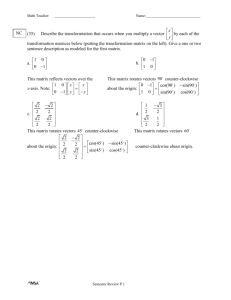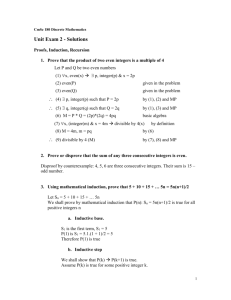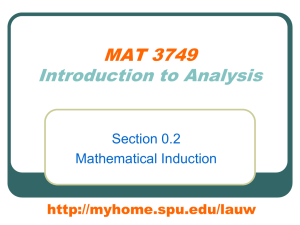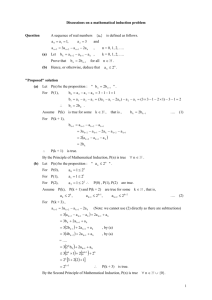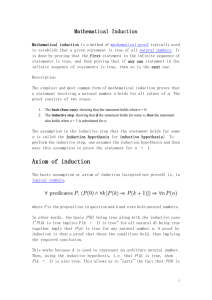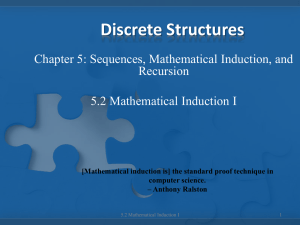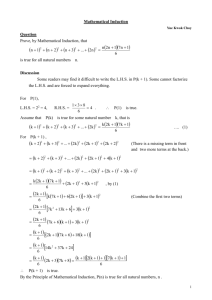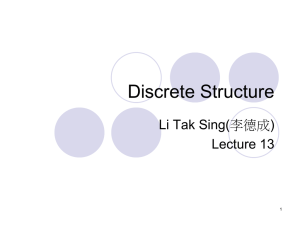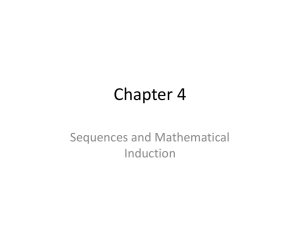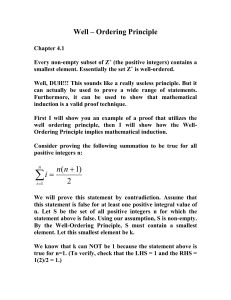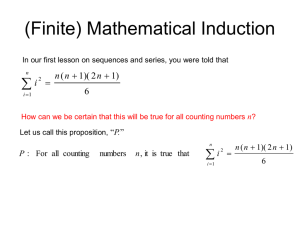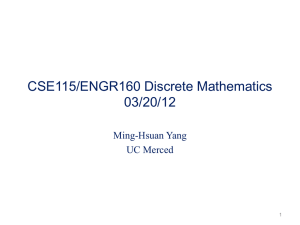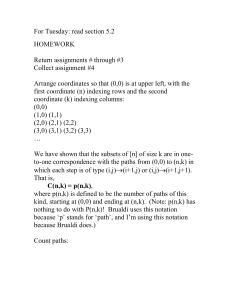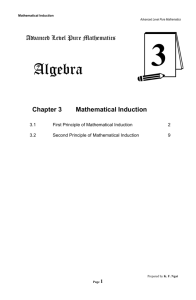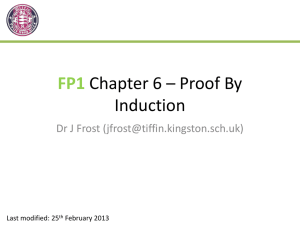Induction3
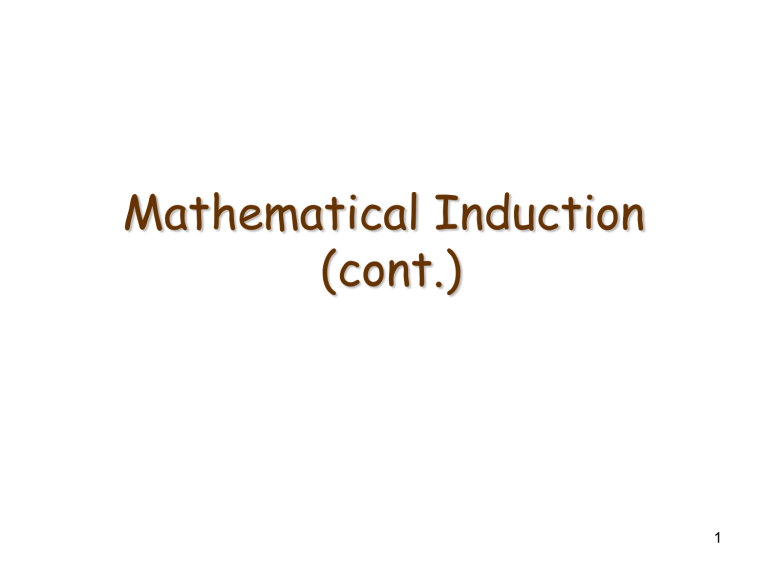
Mathematical Induction
(cont.)
1
Example ( of sum of the first n integers) .
In a round-robin tournament each of the n teams plays every other team exactly once.
What is the total number of games played?
2 ways to solve:
1) Each of the n teams plays n-1 games; this gives a total of n(n-1) games.
But each game was counted exactly twice;
Thus, the total number of games is n(n-1)/2.
2
Example ( of sum of the first n integers) .
2) Team 1 plays n-1 games ;
Team 2 plays n-2 games ( not counting the game with team 1 );
Team 3 plays n-3 games ( not counting the games with teams 1 and 2 );
….
Team n-1 plays 1 game with team n ( not including the games counted before ).
Thus, the total number of games is
1+2+…+(n-2)+(n-1) = n(n-1)/2 by Theorem 1 .
3
Example ( of sum of a geometric sequence) .
If all of your ancestors were distinct, what would be the total number of your ancestors for the past 40 generations?
Solution: The total number is
2+4+8+…+2 39 +2 40 =2 ·(2 0 +2 1 +2 2 +…+2 38 +2 39 )
2
i
39
0
2 i
2
2
40
1
2
1
2
41
2 by Theorem 2
(1)
4
Example ( of sum of a geometric sequence) .
Assuming that each generation represents
30 years, how long is 40 generations?
Answer: 30 ·40 = 1200 years (2)
The total number of people ever lived is approximately 10 billion, which equals 10 10 people.
(3)
What is the conclusion based on (1), (2), (3)?
5
Connection of Mathematical
Induction to traditional principles of
Induction and Deduction
Steps of logical reasoning:
Conjecture a general principle after observing it in a large number of specific instances.
(traditional induction)
Prove the conjecture by mathematical induction .
Use the ( proved ) general principle to infer a conclusion for any specific instance.
(traditional deduction)
Proving a divisibility property by mathematical induction
• Proposition: For any integer n ≥1,
• Proof ( by induction ):
7 n - 2 n is divisible by 5 . ( P(n) )
1) Basis step:
The statement is true for n=1:
7 1 – 2 1 = 7 - 2 = 5 is divisible by 5 .
( P(1)
2) Inductive step:
Assume the statement is true for some k ≥1 ( P(k) )
)
(inductive hypothesis) ; show that it is true for k+1 .
( P(k+1)
7
)
Proving a divisibility property by mathematical induction
Proof (cont.): We are given that
P(k): 7 k - 2 k is divisible by 5 .
(1)
Then 7 k - 2 k = 5a for some a
Z .
(by definition) (2)
We need to show:
P(k+1): 7 k+1 - 2 k+1 is divisible by 5 .
(3)
7 k+1 - 2 k+1 = 7
·
7 k - 2
·
2 k = 5
·
7 k + 2
·
7 k - 2
·
2 k
= 5
·
7 k + 2
·(
7 k - 2 k ) = 5
·
7 k + 2
·
5a (by (2))
Thus, P(n)
= 5
·(
7 k + 2a) which is divisible by 5 . (by def.) is true by induction.
■
8
Proving inequalities by mathematical induction
• Theorem: For all integers n ≥4,
2 n < n! .
( P(n) )
• Proof ( by induction ):
1) Basis step:
The statement is true for n=4:
2 4 = 16 < 24 = 4! .
( P(4)
2) Inductive step:
Assume the statement is true for some k ≥4 ; ( P(k) ) show that it is true for k+1 .
( P(k+1) )
)
Proving inequalities by mathematical induction
Proof (cont.): We are given that
P(k): 2 k < k!
We need to show:
P(k+1): 2 k+1 < (k+1)!
2 k+1 = 2 ·2 k
< 2 ·k!
< (k+1) ·k!
(based on (1))
(since k≥4)
(1)
(2)
= (k+1)!
Thus, P(n) is true by induction.
■
10
Proving inequalities by mathematical induction
• Theorem: For all integers n ≥5, n 2 < 2 n .
( P(n) )
• Proof ( by induction ):
1) Basis step:
The statement is true for n=5:
5 2 =25 < 32 = 2 5 .
( P(5)
2) Inductive step:
Assume the statement is true for some k ≥5 ; ( P(k) ) show that it is true for k+1 .
( P(k+1) )
)
Proving inequalities by mathematical induction
Proof (cont.): We are given that
P(k): k 2 < 2 k .
We need to show:
P(k+1): (k+1) 2 < 2 k+1 .
(k+1) 2 = k 2 +2k+1 < k 2 +2 k (since k≥5)
(1)
(2)
Thus, P(n)
< 2 k + 2 k
(based on (1))
= 2 ·2 k
= 2 k+1 .
is true by induction.
■
12
